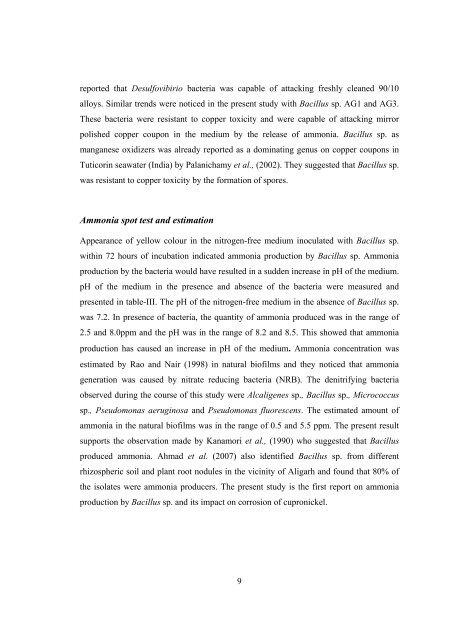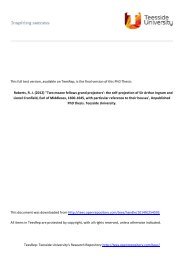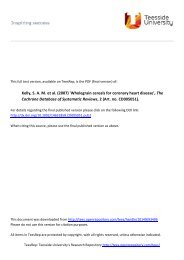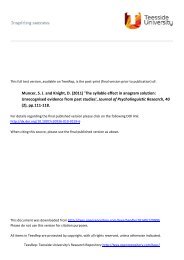Maruthamuthu, S. et al. - Teesside's Research Repository
Maruthamuthu, S. et al. - Teesside's Research Repository
Maruthamuthu, S. et al. - Teesside's Research Repository
You also want an ePaper? Increase the reach of your titles
YUMPU automatically turns print PDFs into web optimized ePapers that Google loves.
eported that Desulfovibirio bacteria was capable of attacking freshly cleaned 90/10<br />
<strong>al</strong>loys. Similar trends were noticed in the present study with Bacillus sp. AG1 and AG3.<br />
These bacteria were resistant to copper toxicity and were capable of attacking mirror<br />
polished copper coupon in the medium by the release of ammonia. Bacillus sp. as<br />
manganese oxidizers was <strong>al</strong>ready reported as a dominating genus on copper coupons in<br />
Tuticorin seawater (India) by P<strong>al</strong>anichamy <strong>et</strong> <strong>al</strong>., (2002). They suggested that Bacillus sp.<br />
was resistant to copper toxicity by the formation of spores.<br />
Ammonia spot test and estimation<br />
Appearance of yellow colour in the nitrogen-free medium inoculated with Bacillus sp.<br />
within 72 hours of incubation indicated ammonia production by Bacillus sp. Ammonia<br />
production by the bacteria would have resulted in a sudden increase in pH of the medium.<br />
pH of the medium in the presence and absence of the bacteria were measured and<br />
presented in table-III. The pH of the nitrogen-free medium in the absence of Bacillus sp.<br />
was 7.2. In presence of bacteria, the quantity of ammonia produced was in the range of<br />
2.5 and 8.0ppm and the pH was in the range of 8.2 and 8.5. This showed that ammonia<br />
production has caused an increase in pH of the medium. Ammonia concentration was<br />
estimated by Rao and Nair (1998) in natur<strong>al</strong> biofilms and they noticed that ammonia<br />
generation was caused by nitrate reducing bacteria (NRB). The denitrifying bacteria<br />
observed during the course of this study were Alc<strong>al</strong>igenes sp., Bacillus sp., Micrococcus<br />
sp., Pseudomonas aeruginosa and Pseudomonas fluorescens. The estimated amount of<br />
ammonia in the natur<strong>al</strong> biofilms was in the range of 0.5 and 5.5 ppm. The present result<br />
supports the observation made by Kanamori <strong>et</strong> <strong>al</strong>., (1990) who suggested that Bacillus<br />
produced ammonia. Ahmad <strong>et</strong> <strong>al</strong>. (2007) <strong>al</strong>so identified Bacillus sp. from different<br />
rhizospheric soil and plant root nodules in the vicinity of Aligarh and found that 80% of<br />
the isolates were ammonia producers. The present study is the first report on ammonia<br />
production by Bacillus sp. and its impact on corrosion of cupronickel.<br />
9





